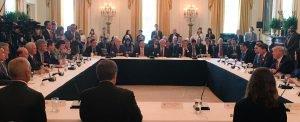President Trump
Top drone executives from PrecisionHawk, Trumbull Unmanned, AirMap, Measure, Kespry and Airspace joined wi-fi community executives and enterprise capitalists for some nose to nose time with U.S. President Donald Trump.
By all reviews, the gang praised Trump for his efforts to restrict authorities regulation and his assist for brand spanking new know-how. “We want them to create new companies and lots of jobs,” Reuters reviews Trump instructed the group. “We’re going to give you the competitive advantage that you need.”
While the wi-fi executives be a part of many industries in asking the federal government to cut back laws, the drone business wants extra authorities enter to extend business drone functions. PrecisionHawk‘s CEO Michael Chasen tweeted: “Clear @WhiteHouse believes emerging tech will drive innovation Now we need forward-leaning regulation for drone industry to grow & thrive.” In his dialogue, Chasen instructed President Trump and the assembled group
In his dialogue, Chasen instructed President Trump and the assembled group that the FAA wants “a little more power,” to control. “This is the one industry where we actually need a little bit more regulation – because the default is actually limiting what the technology can do,” he stated.
Enterprise options supplier Kespry could have gotten probably the most performed picture. Kespry CEO George Mathew introduced President Trump with a Kespry drone, the primary drone contained in the White House, mentioning the security options and explaining among the drone’s makes use of.
Prior to the assembly, the drone execs met with representatives of the FAA, taking the chance to debate drone laws.
The assembly comes at a important time for the drone business, as two new payments may severely impression drone operators. Senator Dianne Feinstein’s “Drone Federalism Act” would protect state rights to control drone exercise. The considerably deceptively named “Drone Innovation Act” would do a lot the identical factor, permitting states to control airspace as much as 200 ft in altitude – which might restrict all takeoffs and touchdown. Either of those payments would create the FAA’s nightmare situation of a “Patchwork Quilt” of drone legal guidelines, requiring business operators who cross state strains to stick to totally different legal guidelines in every space.
